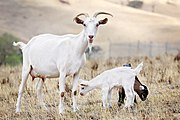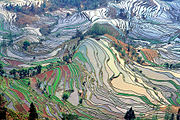Portal:Agriculture

Agriculture encompasses crop and livestock production, aquaculture, and forestry for food and non-food products. Agriculture was a key factor in the rise of sedentary human civilization, whereby farming of domesticated species created food surpluses that enabled people to live in cities. While humans started gathering grains at least 105,000 years ago, nascent farmers only began planting them around 11,500 years ago. Sheep, goats, pigs, and cattle were domesticated around 10,000 years ago. Plants were independently cultivated in at least 11 regions of the world. In the 20th century, industrial agriculture based on large-scale monocultures came to dominate agricultural output.
As of 2021[update], small farms produce about one-third of the world's food, but large farms are prevalent. The largest 1% of farms in the world are greater than 50 hectares (120 acres) and operate more than 70% of the world's farmland. Nearly 40% of agricultural land is found on farms larger than 1,000 hectares (2,500 acres). However, five of every six farms in the world consist of fewer than 2 hectares (4.9 acres), and take up only around 12% of all agricultural land. Farms and farming greatly influence rural economics and greatly shape rural society, effecting both the direct agricultural workforce and broader businesses that support the farms and farming populations.
The major agricultural products can be broadly grouped into foods, fibers, fuels, and raw materials (such as rubber). Food classes include cereals (grains), vegetables, fruits, cooking oils, meat, milk, eggs, and fungi. Global agricultural production amounts to approximately 11 billion tonnes of food, 32 million tonnes of natural fibers and 4 billion m3 of wood. However, around 14% of the world's food is lost from production before reaching the retail level.
Modern agronomy, plant breeding, agrochemicals such as pesticides and fertilizers, and technological developments have sharply increased crop yields, but also contributed to ecological and environmental damage. Selective breeding and modern practices in animal husbandry have similarly increased the output of meat, but have raised concerns about animal welfare and environmental damage. Environmental issues include contributions to climate change, depletion of aquifers, deforestation, antibiotic resistance, and other agricultural pollution. Agriculture is both a cause of and sensitive to environmental degradation, such as biodiversity loss, desertification, soil degradation, and climate change, all of which can cause decreases in crop yield. Genetically modified organisms are widely used, although some countries ban them. (Full article...)
Ethiopia's agriculture is plagued by periodic drought, soil degradation caused by overgrazing, deforestation, high population density, high levels of taxation and poor infrastructure (making it difficult and expensive to get goods to market). Yet agriculture is the country's most promising resource. A potential exists for self-sufficiency in grains and for export development in livestock, grains, vegetables, and fruits. As many as 4.6 million people need food assistance annually.
Agriculture accounts for 46.3% of the GDP, 83.9% of exports, and 80% of the labour force. Many other economic activities depend on agriculture, including marketing, processing, and export of agricultural products. Production is overwhelmingly of a subsistence nature, and a large part of commodity exports are provided by the small agricultural cash-crop sector. Principal crops include coffee, pulses (e.g., beans), oilseeds, cereals, potatoes, sugarcane, and vegetables. Exports are almost entirely agricultural commodities, and coffee is the largest foreign exchange earner. Ethiopia is Africa's second biggest maize producer. Ethiopia's livestock population is believed to be the largest in Africa, and in 2006/2007 livestock accounted for 10.6% of Ethiopia's export income, with leather and leather products making up 7.5% and live animals 3.1%.
Ethiopi's major staple crops include a variety of cereals, pulses, oilseeds, and coffee. Grains are the most important field crops and the chief element in the diet of most Ethiopians. The principal grains are teff, wheat, barley, corn, sorghum, and millet. The first three are primarily cool-weather crops cultivated at altitudes generally above 1,500 meters. Teff, indigenous to Ethiopia, furnishes the flour for enjera, an sourdough pancakelike bread that is the principal form in which grain is consumed in the highlands and in urban centers throughout the country. Barley is grown mostly between 2,000 and 3,500 meters. A major subsistence crop, barley is used as food and in the production of tella, a locally produced beer.
Sorghum, millet, and corn are cultivated mostly in warmer areas at lower altitudes along the country's western, southwestern, and eastern peripheries. Sorghum and millet, which are drought resistant, grow well at low elevations where rainfall is less reliable. Corn is grown chiefly between elevations of 1,500 and 2,200 meters and requires large amounts of rainfall to ensure good harvests. These three grains constitute the staple foods of a good part of the population and are major items in the diet of the nomads.
Pulses are the second most important element in the national diet and a principal protein source. They are boiled, roasted, or included in a stew-like dish known as wot, which is sometimes a main dish and sometimes a supplementary food. Pulses, grown widely at all altitudes from sea level to about 3,000 meters, are more prevalent in the northern and central highlands. Pulses were a particularly important export item before the revolution. (Full article...)

- – When a task is completed, please remove it from the list.
The following Wikimedia Foundation sister projects provide more on this subject:
-
Commons
Free media repository -
Wikibooks
Free textbooks and manuals -
Wikidata
Free knowledge base -
Wikinews
Free-content news -
Wikiquote
Collection of quotations -
Wikisource
Free-content library -
Wikiversity
Free learning tools -
Wiktionary
Dictionary and thesaurus

- Agronomy Journal - the American Society of Agronomy
- Agronomy for Sustainable Development Journal
- European Journal of Agronomy
- Journal of Agronomy and Crop Science
- Journal of Organic Systems
- Agriculture, Ecosystems & Environment
- Agriculture and Human Values
- Computers and Electronics in Agriculture
- Precision Agriculture
- Experimental Agriculture
- Journal of Integrative Agriculture
- Journal of the Science of Food and Agriculture
- Renewable Agriculture and Food Systems
- Biological Agriculture & Horticulture
See also:



































































